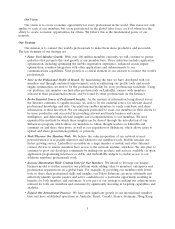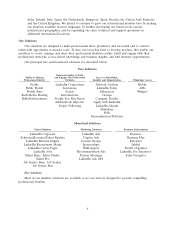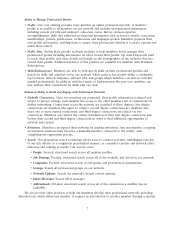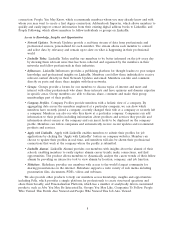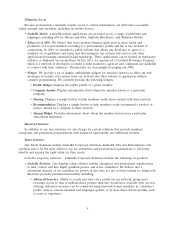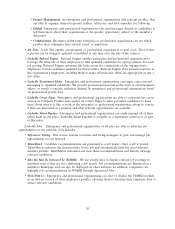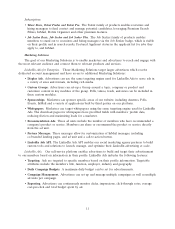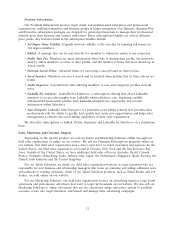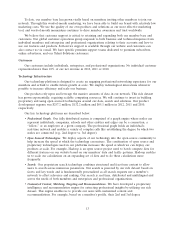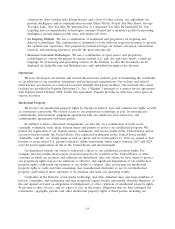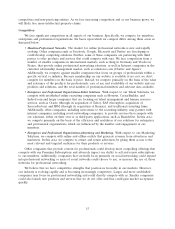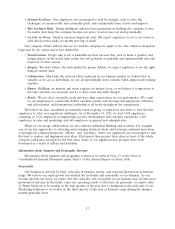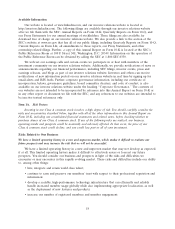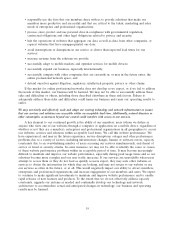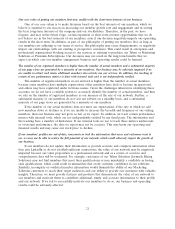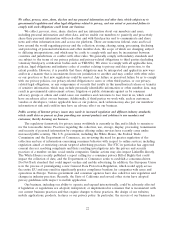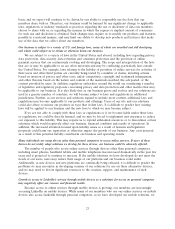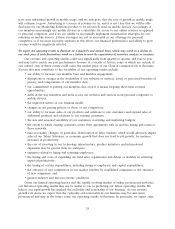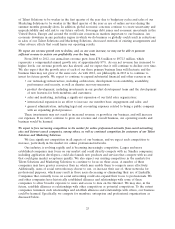LinkedIn 2012 Annual Report Download - page 17
Download and view the complete annual report
Please find page 17 of the 2012 LinkedIn annual report below. You can navigate through the pages in the report by either clicking on the pages listed below, or by using the keyword search tool below to find specific information within the annual report.competitors and non-practicing entities. As we face increasing competition and as our business grows, we
will likely face more intellectual property claims.
Competition
We face significant competition in all aspects of our business. Specifically, we compete for members,
enterprises and professional organizations; the bases upon which we compete differ among these areas as
discussed below.
•Members-Professional Networks. The market for online professional networks is new and rapidly
evolving. Other companies such as Facebook, Google, Microsoft and Twitter are developing or
could develop competing solutions. Further, some of these companies are partnering with third
parties to offer products and services that could compete with ours. We face competition from a
number of smaller companies in international markets, such as Xing in Germany and Viadeo in
France, that provide online professional networking solutions, as well as Internet companies in the
customer relationship management market, such as salesforce.com (Chatter and Jigsaw).
Additionally, we compete against smaller companies that focus on groups of professionals within a
specific vertical or industry. Because membership on our website is available at no cost, we don’t
compete for members on the basis of price. Instead, we compete primarily on the basis of the value
and relevance of the products for professionals, ease of use and availability of our website and our
products and solutions, and the total number of professional members and relevant data available.
•Enterprises and Professional Organizations-Talent Solutions. With respect to our Talent Solutions, we
compete with established online recruiting companies such as Monster, CareerBuilder, and
Indeed.com and larger companies that are focusing on talent management and human resource
services, such as Oracle (through its acquisition of Taleo), SAP (through its acquisition of
SuccessFactors) and IBM (through its acquisition of Kenexa), and traditional recruiting firms.
Additionally, other companies, including newcomers to the recruiting industry, may partner with
internet companies, including social networking companies, to provide services that compete with
our solutions, either on their own or as third party applications, such as BranchOut. In this area,
we compete primarily on the basis of the efficiency and usefulness of our solutions for enterprises
and professional organizations, which are influenced by the number and engagement of our
members.
•Enterprises and Professional Organizations-Advertising and Marketing. With respect to our Marketing
Solutions, we compete with online and offline outlets that generate revenue from advertisers and
marketers. In this area, we compete to attract and retain advertisers by giving them access to the
most relevant and targeted audiences for their products or services.
Other companies that provide content for professionals could develop more compelling offerings that
compete with our Premium Subscriptions and adversely impact our ability to sell and renew subscriptions
to our members. Additionally, companies that currently focus primarily on social networking could expand
into professional networking or users of social networks could choose to use, or increase the use of, those
networks for professional networking.
We believe that we have competitive strengths that position us favorably in our markets. However,
our industry is evolving rapidly and is becoming increasingly competitive. Larger and more established
companies may focus on professional networking and could directly compete with us. Smaller companies
could also launch new products and services that we do not offer and that could gain market acceptance
quickly.
15


